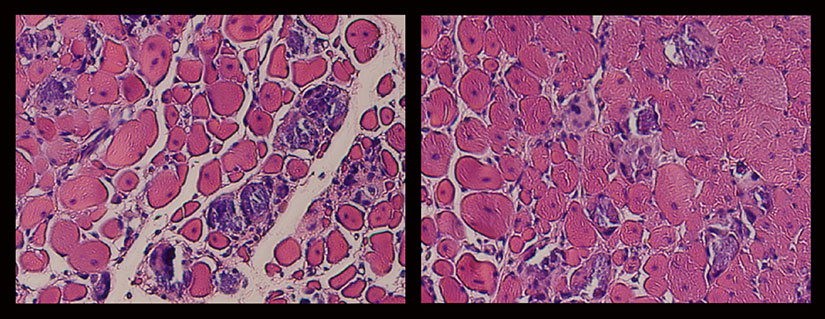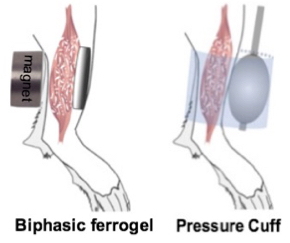Mechanotherapy may replace drug and cellular therapies for injured muscle tissue
January 28, 2016

These microscopic images reveal the dramatic effect that a novel mechanotherapy has on muscle regeneration of injured tissue over a period of two weeks: no treatment is pictured (left), vs. direct mechanical stimulation of the muscle (right), resulting in two-and-a-half-fold improvement in muscle regeneration, reduced tissue scarring and fibrosis, and a visible increase in the density of muscle cells. (credit: Wyss Institute at Harvard University)
Engineers and biomedical scientists at the Wyss Institute for Biologically Inspired Engineering at Harvard University and the Harvard School of Engineering and Applied Sciences have developed a promising new approach for repairing severely damaged skeletal muscles: direct mechanical stimulation. It may be appropriate for major injuries commonly caused by motor vehicle accidents, other traumas, or nerve damage, which can lead to extensive scarring, fibrous tissue, and loss of muscle function.
The new method could one day promote skeletal muscle regeneration and replace or enhance drug- and cell-based regenerative treatments. The finding was published on January 25 in the journal Proceedings of the National Academy of Sciences.

Two mechanotherapy methods of generating cyclic mechanical compressions (credit: Christine A. Cezar et al./PNAS)
The team investigated two potential mechanotherapies for a two-week period, using mice with muscle injury and hind limb ischemia:
- Ferrogel implant. They implanted a biocompatible magnetized gel called a “biphasic ferrogel,” located in direct contact with the damaged tissue. They then used external magnetic pulses to apply cyclic stimulation to the muscle.
- Pressurized cuff. They fitted a soft robotic, non-invasive pressurized cuff over the injured leg and used pulses of air to cyclically massage the hind leg.
Finding: mechanical stimulation of muscle alone can foster regeneration
To their surprise, the researchers discovered that both cyclic mechanical stimulation — provided by either magnetized gel or robotic cuff — resulted in a two-and-a-half-fold improvement in muscle regeneration and reduced tissue scarring over the course of two weeks (compared to no-treatment controls), ultimately leading to an improvement in muscle function.
That suggested that the use of non-invasive pressurized cuffs or devices alone could one day help heal patients suffering from severe muscle injuries — no invasive procedure required. The direct stimulation of muscle tissue increases the transport of oxygen, nutrients, fluids and waste removal from the site of the injury, which are all vital components of muscle health and repair, according to the reseachers.
Replacing drugs and cells
“Until now, most approaches to muscle regeneration have been biologic, relying on the use of drugs or cells,” said Christine Cezar, Ph.D., lead author on the study, who completed her doctoral research at the Wyss Institute and Harvard SEAS. “Our finding that mechanical stimulation alone is enough to enhance muscle repair could open the door to new non-biologic therapies, or even combinatorial therapies that employ both mechanical and biological interventions to treat severely damaged skeletal muscles.”
According to Harvard bioengineer David Mooney, Ph.D., senior author on the new study, one of the most exciting aspects of this research is that its translation to the clinic in the form of a stimulatory device could be relatively rapid as compared to drug or cell therapies. The team plans to explore how the findings can make the jump from the laboratory to the clinic.*
“Chemistry tends to dominate the way we think about medicine, but it has become clear that physical and mechanical factors play very critical roles in regulating biology,” said Mooney, a Wyss Institute Core Faculty member and the Robert P. Pinkas Family Professor of Bioengineering at the Harvard John A. Paulson School of Engineering and Applied Sciences (SEAS). “The results of our new study demonstrate how direct physical and mechanical intervention can impact biological processes and can potentially be exploited to improve clinical outcomes.”
Down the road, the principle of using mechanical stimulation to enhance regeneration or reduce formation of scarring or fibrosis could also be applied to a wide range of medical devices that interface mechanical components with body tissues, the researchers say. Currently, such medical devices are often plagued by the formation of thickened tissue capsules that form at the intersection of machine and man.
DIY muscle treatment?
The finding raises a question: what about testing conventional post-operative external pneumatic compression devices (such as an inflatable cuff or bootie that’s inflated and deflated to apply intermittent pressure) in clinic or at home (with physician oversight)? An improved device could have doctor- or patient-adjustable pressure settings for various levels of injury or various stages of healing. And what about deep massage**, which has the advantage of patient feedback on excessive pain (indicating possible tissue damage)?
* The multi-disciplinary team spanning the Wyss Institute’s Programmable Nanomaterials and Bioinspired Robotics platforms was led by Mooney and also included soft roboticist Conor Walsh, Ph.D., who is a Wyss Core Faculty member, Associate Professor of Mechanical and Biomedical Engineering at Harvard SEAS and Founder of the Harvard Biodesign Lab, and biomechanical engineer Georg Duda, Ph.D., who is a Wyss Associate Core Faculty member, Vice-Director of the Berlin-Brandenburg Center for Regenerative Therapies (BCRT) and the Director of the Julius Wolff Institute for Biomechanics and Musculoskeletal Regeneration at Charité-Universitätsmedizin Berlin.
** In the PNAS paper, the authors note that “a role for massage therapy as a potent immunomodulator after exercise-induced muscle damage in humans has been reported” and that there is some evidence that massage therapy or physical manipulation may promote recovery by increasing blood flow.
Abstract of Biologic-free mechanically induced muscle regeneration
Severe skeletal muscle injuries are common and can lead to extensive fibrosis, scarring, and loss of function. Clinically, no therapeutic intervention exists that allows for a full functional restoration. As a result, both drug and cellular therapies are being widely investigated for treatment of muscle injury. Because muscle is known to respond to mechanical loading, we investigated instead whether a material system capable of massage-like compressions could promote regeneration. Magnetic actuation of biphasic ferrogel scaffolds implanted at the site of muscle injury resulted in uniform cyclic compressions that led to reduced fibrous capsule formation around the implant, as well as reduced fibrosis and inflammation in the injured muscle. In contrast, no significant effect of ferrogel actuation on muscle vascularization or perfusion was found. Strikingly, ferrogel-driven mechanical compressions led to enhanced muscle regeneration and a ∼threefold increase in maximum contractile force of the treated muscle at 2 wk compared with no-treatment controls. Although this study focuses on the repair of severely injured skeletal muscle, magnetically stimulated bioagent-free ferrogels may find broad utility in the field of regenerative medicine.